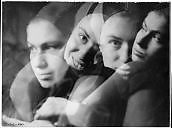Light is to Moholy-Nagy what a pencil is to a draughtsman. He lived during that fascinating era when the art world experienced a transition to modern times: the interwar period, a time of world-famous art movements like the Bauhaus and De Stijl. Moholy-Nagy was a real citizen of the world. His life was one long journey, from Hungary, the country of his birth, to Vienna, Berlin, Amsterdam, London and Chicago – sometimes driven by emerging political threats, at other times in search of a new artistic challenge. Moholy-Nagy could turn his hand to anything. Besides working as an artist, he was also an intellectual, critic, thinker and teacher, but above all he was a utopian. Gemeentemuseum Den Haag has gathered together over 160 objects from 30 international collections to present a major exhibition showcasing his artistic legacy.
László Moholy-Nagy made photography and film – the essential ingredient of which was light – the leading artistic media of his time. Through photography and film, art suddenly became accessible to all. This democratisation of the arts was entirely consistent with Moholy-Nagy’s utopian ideas. To him, art was part of an attitude to life, a collective mentality in which art and all other aspects of life merge in a Gesamtkunstwerk (‘integrated artwork’) or, better still, a Gesamtwerk (‘integrated work’), leading to shared progress. He was convinced of art’s ability to educate. ‘Art sharpens one’s senses, one’s view, one’s mind and one’s observations,’ he believed.
László Moholy-Nagy was at the centre of the web of European Modernism. He met internationally renowned artists, like the Russian Constructivists, with whom he felt a sense of kinship through their shared ideas on the role of art in improving society. Moholy-Nagy also got to know Bauhaus founder Walter Gropius. The Bauhaus was the famous school for architecture, art and design where the personal development of students played an important role. This too was part of the revolutionary idea of merging art and society. Moholy-Nagy went to teach at the Bauhaus and when he left later for the United States founded the New Bauhaus in Chicago.
Besides ten paintings from the period 1922-1926, the exhibition will also feature his most important films and more than a hundred photographic works. In the 1930s Moholy-Nagy had close ties with the Netherlands, living and working here for two years as an art director, and coming into contact with Piet Mondrian and Theo van Doesburg. The exhibition will therefore also include related works by Paul Schuitema, Piet Zwart, Gerard Kiljan and others. Moholy-Nagy’s work perfectly suits the Gemeentemuseum’s exhibition and collection policy, alongside famous avant-garde figures like Piet Zwart, Georges Vantongerloo and Man Ray.
